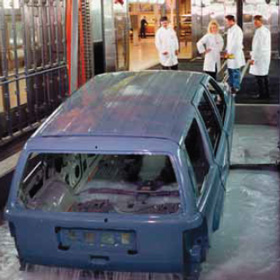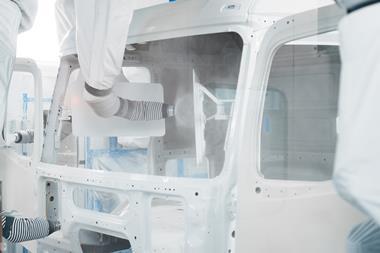With five and seven year corrosion warranties being offered on many cars, the need for e-coat protection has never been greater
For over 40 years, e-coats have been protecting cars from corrosion. BASF Coatings has now landed a coup with CathoGuard 800 and 900. The new automotive e-coats offer ideal metal protection, are tin-free and contain less than one percent of solvents. CathoGuard 800 and 900 meet the industry’s tough standards for environmental and corrosion protection and provide cars with perfect surfaces.
 Furthermore, they are HAPS-free, meaning they do not contain any chemicals on the US Environmental Protection Agency’s hazardous air pollutants list. While the new product lines are currently being launched on today’s market, they already meet all the requirements posed by the environmental legislation and application processes of the future. A wise move, because sooner or later, new laws will stipulate that e-coats must be tin-free. On the other hand, the new paints are ideally suited for integrated application processes in which the primer coat is dispensed with. Another advantage of the new technologies is the way they can be integrated into state-of-the-art pretreatment processes.
Furthermore, they are HAPS-free, meaning they do not contain any chemicals on the US Environmental Protection Agency’s hazardous air pollutants list. While the new product lines are currently being launched on today’s market, they already meet all the requirements posed by the environmental legislation and application processes of the future. A wise move, because sooner or later, new laws will stipulate that e-coats must be tin-free. On the other hand, the new paints are ideally suited for integrated application processes in which the primer coat is dispensed with. Another advantage of the new technologies is the way they can be integrated into state-of-the-art pretreatment processes.
BASF Coatings is one of the leaders in the area of e-coating technology. By the late 1970s, the first e-coating line for small parts in the European automotive industry had already been filled. Then, in the late 1980s, BASF Coatings launched the CathoGuard e-coating technology. The product line’s exceptional features include its optimized edge protection, flow and throwing power. CathoGuard 300 to 500 were the first lead-free e-coating product lines to have outstanding corrosion and stone-chipping protection properties.
Protection and support with a global reach
BASF Coatings produces its e-coating products in Germany, Spain, Brazil, the US, China and India. All of the production sites have product labs that test the paints for properties such as deposition behavior, stability and corrosion protection.
The labs test product innovations that can be tailored to the particular customer’s needs while they are still in the development phase.
These days, innovative products alone aren’t enough. With CathoCare, all CathoGuard customers also have a sophisticated service concept at their disposal. CathoCare offers a wide range of tools that assist in the entire process, from planning all the way to process monitoring. In addition, BASF Coatings’ employees also work directly on site to optimize production processes. “Our service team supports customers on site in controlling paint lines in order to guarantee smooth process flows. For instance, we offer regular analysis of e-coating samples from the car manufacturers’ and automotive suppliers’ plants,” explained Dr. Achim Gast, head of BASF Coatings’ E-Coat & Primer Competence Center. He added, “CathoGuard 800 and 900 are true innovative leaps in e-coating. Combined with our CathoCare service concept, we offer our customers a complete package that is one of a kind in this business.”
The first step involves giving the body a primer coat by means of cathodic e-coating. This principally serves as anti-corrosion protection and provides an excellent surface preparation for the subsequent elements of the paint system. In this first coating step, the body literally takes a bath: The coating particles are deposited on the steel panels with the aid of an electric current in the cathodic e-coat bath. The body is then rinsed off before it moves on to the oven, where the paint is baked at approx. 180 degrees Celsius.
The environment also benefits from modern cathodic e-coats: Lead can be dispensed with, and emissions can be reduced. Pre-treatment processes which do not involve environmentally polluting heavy metals are possible, and the bath material can be re-used, thereby conserving resources. The lead-free products of the CathoGuard® 300 and CathoGuard® 500 technology series from BASF Coatings’ product portfolio are used in the cathodic e-coat sector. CathoGuard 800 and CathoGuard 900 are tin-free future technologies that comply with environmental legislation.





































